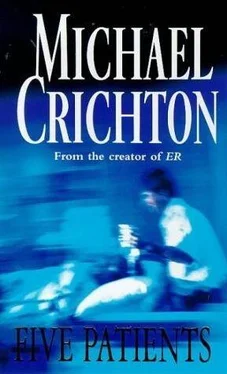Michael Crichton - Five Patients
Здесь есть возможность читать онлайн «Michael Crichton - Five Patients» весь текст электронной книги совершенно бесплатно (целиком полную версию без сокращений). В некоторых случаях можно слушать аудио, скачать через торрент в формате fb2 и присутствует краткое содержание. Жанр: Триллер, на английском языке. Описание произведения, (предисловие) а так же отзывы посетителей доступны на портале библиотеки ЛибКат.
- Название:Five Patients
- Автор:
- Жанр:
- Год:неизвестен
- ISBN:нет данных
- Рейтинг книги:5 / 5. Голосов: 1
-
Избранное:Добавить в избранное
- Отзывы:
-
Ваша оценка:
- 100
- 1
- 2
- 3
- 4
- 5
Five Patients: краткое содержание, описание и аннотация
Предлагаем к чтению аннотацию, описание, краткое содержание или предисловие (зависит от того, что написал сам автор книги «Five Patients»). Если вы не нашли необходимую информацию о книге — напишите в комментариях, мы постараемся отыскать её.
Five Patients — читать онлайн бесплатно полную книгу (весь текст) целиком
Ниже представлен текст книги, разбитый по страницам. Система сохранения места последней прочитанной страницы, позволяет с удобством читать онлайн бесплатно книгу «Five Patients», без необходимости каждый раз заново искать на чём Вы остановились. Поставьте закладку, и сможете в любой момент перейти на страницу, на которой закончили чтение.
Интервал:
Закладка:
At nine, Dr. Minna examined the patient again and agreed that the tenderness was impressive, particularly after a heavy dose of morphine. An X-ray study of the gall bladder was planned. At eleven, he was seen by the surgeons who agreed that gall-bladder infection was possible, even though bilirubin and amylase tests were normal. They advised waiting on surgery, however.
At noon, the gastrointestinal consult reviewed the barium enema, which was normal. They concluded that "we remain in the dark regarding diagnosis but would agree that bacterial sepsis secondary to a right abdominal lesion is the best bet." They suggested, however, that perforated small bowel, duodenal lesion, pancreatitis, and a number of other possibilities remained, and advised an upper GI series of X rays.
At approximately the same time, the attending physician on the wards, Dr. Kurt Bloch, noted that Mr. O'Connor presented "a very puzzling problem," with some findings suggestive of right-upper-abdomen pathology, but no clear indication of what it might be.
Later in the day the surgeons again saw Mr. O'Connor, but disagreed with earlier interpretations. They felt his abdomen had no peritoneal signs, and no localizing signs.
At eight in the evening, the neuromedical consult again evaluated Mr. O'Connor, and concluded that his condition still gave no hint of central nervous system disease. They felt that findings pointed to an abdominal problem.
That same evening, more abnormal laboratory values came back from the labs. They had been taken the day of admission, and included an elevated uric acid level of 17.1 and an elevated alkaline phosphatase level of 37.6. The alkaline phosphatase test was repeated, and was found to be still higher, at 61.0. Two other enzymes were also slightly high: the serum glutamic oxalocetic transaminase, or SGOT, was 123, and the lactic dehydrogenase, or LDH, was 540. Blood samples were immediately drawn for repeat determinations.
These two enzymes, SGOT and LDH, are measured as indexes of cell destruction. Cells normally contain them; if the cells die, they rupture and release their enzymes to the bloodstream. A rise in enzyme levels is thought to correspond moderately well with the degree of cellular damage, particularly when examined over several days. However, these enzymes are found in many kinds of cells, and thus an enzyme rise does not pinpoint precisely the area of destruction. For example, heart, skeletal muscle, brain, liver, and kidneys all contain SGOT; damage to any of them will produce an SGOT rise. In recent years, there has been a search for enzymes specific to certain tissues. Cre-atinine phosphokinase, or CPK, is usually considered more specific for heart damage.
At 3:30 a.m., Michael Soper, a medical resident, got back the new set of enzyme values. Everything was further increased: SGOT was now 640, LDH 1250, and CPK very high, at 320. He wrote: "I've never seen a CPK this high and don't know where it is coming from. Doubt it is solely of cardiac origin. Electrocardiogram tonight is unchanged."
At 7 a.m., on morning rounds, Mr. O'Connor's abdomen was again without localizing signs pointing to disease on the right side. All cultures were back from the labs; all were negative. It was decided to continue only penicillin and chloramphen-icol, and discontinue all other antibiotics.
Later in the morning, the patient was seen by the infectious-disease consult, which concluded that the agitation and unresponsiveness were almost certainly secondary to gastrointestinal disorders and metabolic problems. The elevated enzymes could be the consequence of insufficient oxygen and shock, present at admission. However, they noted that the elevated alkaline phosphatase and elevated uric acid were unexplained. They suggested the possibility, previously unconsidered, of staphylococcal food poisoning.
Since no information could be obtained directly from the patient, his wife was closely requestioned about symptoms of thyroid disease, or longstanding diarrhea or other GI problems. The paregoric that the patient had taken on the day of admission was brought into the hospital and checked; it was, indeed, paregoric.
During this period the patient was examined by Dr. Alexander Leaf, the chief of medicine, and Dr. Daniel Federman, the assistant chief, as well as by a large number of other physicians, in an informal brainstorming session. Every conceivable diagnosis, including mushroom poisoning and cholera, was considered at this time.
The patient's condition remained unchanged.
Continued problems with oxygenating the patient's bloodstream produced a consultation by the respiratory unit, which advised drying the lungs as much as possible, naso-tracheal suctioning, encouraging coughing, and close monitoring by arterial blood gases. The patient improved somewhat during the day, becoming less wild. That evening, for the first time, he responded to his name.
The patient was more alert. He was seen again by the surgeons, who noted his abdomen was still soft, without any indications for surgery. His dose of Valium, to contain his agitation, was reduced.
He was seen in the morning by the neurological consults, who felt that he was "still quite ob-tunded," confused and disoriented. Nonetheless his progress since admission was striking. He could answer questions. When asked where he was, he said, "the hospital," though he could not specify which one. When asked his name, he said, "John." He could state his age. He was taken off Valium entirely. His temperature continued to fluctuate in the range of 99°-101°F. Dr. Minna wrote: "He is better in all ways."
Lab values, back from the day before, continued to climb. CPK had now gone to 2900, the highest in the history of the hospital. There was still no explanation for these enzyme changes. The patient continued to improve in alertness and responsiveness, though his mental function was far from satisfactory. In answer to questions, he said that one plus one was "one," and two plus two was "five."
He was able to carry out verbal commands such as "Squeeze my hand" and "Open your eyes." However, for the most part he lay in bed with his eyes closed; he initiated little spontaneous activity, and never spoke except in reply to questions.
His Foley catheter was removed. He was able to urinate in the normal manner. He was more active mentally, and remembered his last name, for the first time.
Blood cultures now revealed growth of a gram-negative bacillus, identified as Bacteroides, probably of bowel origin. The patient was sufficiently improved that he could be questioned about toxins, drugs, mushrooms, work exposure, and possible ingestions of heavy metals; there was no evidence for any of these. He was seen again by surgeons, who concluded that his abdomen was soft, with normal bowel sounds.
Barium enema was repeated, looking for diver-ticulitis or other sources of infection. None was seen.
He was seen by the neurological consults, who observed mild proximal muscle weakness and suggested study of the electrical activity of the muscles, by electromyography. He was also noted to have mushy swelling of his extremities.
Electromyography was normal. It was decided to discontinue his chloramphenicol antibiotic and see if he remained without fever.
Chloramphenicol was stopped. The patient did well, taking liquids by mouth.
The patient's mental condition continued to improve. A repeat kidney X ray was read as normal.
Читать дальшеИнтервал:
Закладка:
Похожие книги на «Five Patients»
Представляем Вашему вниманию похожие книги на «Five Patients» списком для выбора. Мы отобрали схожую по названию и смыслу литературу в надежде предоставить читателям больше вариантов отыскать новые, интересные, ещё непрочитанные произведения.
Обсуждение, отзывы о книге «Five Patients» и просто собственные мнения читателей. Оставьте ваши комментарии, напишите, что Вы думаете о произведении, его смысле или главных героях. Укажите что конкретно понравилось, а что нет, и почему Вы так считаете.









